There’s something about the bright colors and fresh flavors of this Healthy Vegetable Pasta Primavera Recipe that instantly lifts your mood. It’s light but still so satisfying — a perfect way to sneak in a rainbow of veggies while enjoying creamy, comforting pasta.
Jump to:
Why You'll Love This Recipe
This Healthy Vegetable Pasta Primavera Recipe quickly became one of my go-to weeknight dinners because it strikes the ideal balance of creamy sauce and crisp-tender vegetables. The veggies add a fresh pop of flavor and texture, making every bite exciting.
- Versatile & Adaptable: You can swap in whatever veggies you have on hand — perfect for cleaning out the fridge or seasonal picking.
- Balanced Flavor: The subtle creaminess combined with a hint of lemon and fresh herbs keeps it vibrant without feeling heavy.
- Simple & Quick: Ready in about 30 minutes, it’s perfect for busy days when you want a healthy meal fast.
- Crowd-Pleaser: Everyone from veggie lovers to picky eaters tends to enjoy this dish — and it makes enough to share (or save for lunch!).
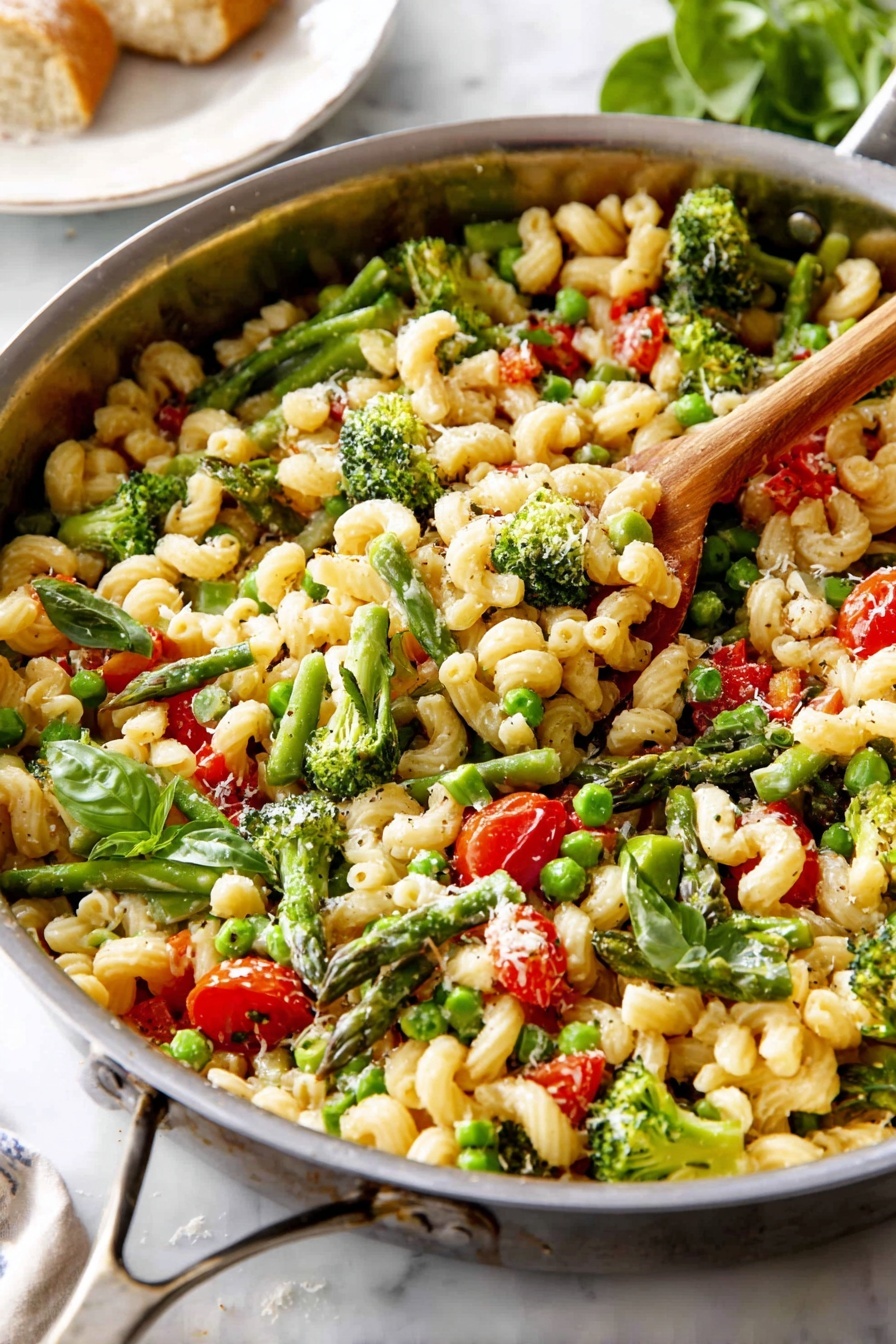
Ingredients & Why They Work
The beauty of this Healthy Vegetable Pasta Primavera Recipe lies in the harmony of fresh, colorful vegetables and a silky, herb-laced sauce. Each ingredient plays a role — from the crunchy broccoli to the sweet cherry tomatoes — creating layers of texture and flavor.

- Cavatappi or Short Pasta: Its spiral shape holds the sauce perfectly, but penne or fusilli work beautifully too.
- Extra Virgin Olive Oil: Adds richness and helps sauté the aromatics without overpowering the delicate veggies.
- Red Onion: Offers a gentle sweetness and depth when lightly sautéed.
- Broccoli Florets: Provide crunch and a vibrant green color that balances the dish.
- Yellow Squash & Zucchini: These tender veggies bring mild flavor and soak up the creamy sauce.
- Asparagus: Adds a lovely snap and seasonal freshness.
- Red Bell Pepper: Brings sweetness and a touch of bright red color.
- Cherry Tomatoes: Bursting with juiciness, they add acidity and balance the richness.
- Garlic & Red Pepper Flakes: For that warm, slightly spicy aromatic kick.
- Heavy Cream (or Evaporated Milk): Gives the sauce a dreamy, velvety texture without being too heavy.
- Chicken Broth: Adds savory depth; you can use vegetable broth to keep it vegetarian.
- Cornstarch: Thickens the sauce just right without clumping.
- Dried Oregano, Parsley, Thyme: Classic Italian herbs that brighten and add complexity.
- Lemon Juice: The secret weapon—it lifts all the flavors with a fresh citrus zing.
- Parmesan Cheese: Use freshly grated for the best melting and rich umami flavor.
- Frozen Petite Peas: A sweet pop of green, adding both color and texture.
- Fresh Basil: Stirred in at the end for a burst of herbaceous aroma and taste.
Make It Your Way
I love tweaking this Healthy Vegetable Pasta Primavera Recipe depending on what’s fresh and what mood I’m in — sometimes I’ll add sautéed mushrooms for an earthy note or toss in some grilled chicken for extra protein. Don’t hesitate to put your own spin on it!
- Swap the Veggies: In spring, add peas and asparagus; in late summer, try adding chunks of roasted eggplant or zucchini blossoms.
- Make it Vegan: Use coconut cream instead of heavy cream and nutritional yeast in place of Parmesan—still delicious!
- Spice it Up: If you like heat, double the red pepper flakes or add a dash of your favorite hot sauce.
- Pasta Choices: I often use fusilli when I run out of cavatappi — anything with nooks and crannies will catch the sauce well.
Step-by-Step: How I Make Healthy Vegetable Pasta Primavera Recipe
Step 1: Cook the Pasta Perfectly
Start by boiling your pasta in salted water according to package directions — but here’s my trick: check it a minute or two before the recommended time to get that perfect al dente bite. Reserve half a cup of the pasta water before draining; that starchy liquid will help you adjust the sauce’s consistency later.
Step 2: Sauté the Vegetables Just Right
Heat most of your olive oil in a large pan and start with the red onions and broccoli, cooking them for about three minutes to soften but keep crispness. Then add your squash, zucchini, asparagus, and bell pepper along with a pinch of salt and pepper. Give them a quick two-minute toss until everything is tender-crisp — keeping that snap is key! Before the veggies get soft, transfer them to a bowl to keep warm.
Step 3: Build the Creamy Sauce
In the now-empty skillet, add the last tablespoon of olive oil and sauté minced garlic and red pepper flakes for just 30 seconds — don’t burn the garlic! Turn the heat down low and slowly pour in the heavy cream. Whisk together chicken broth and cornstarch, then add that, plus the dried herbs, and salt. Let this simmer gently for 3 to 5 minutes until thickened and luscious.
Step 4: Finish with Cheese, Lemon & Herbs
Stir in half the Parmesan until melted, then add lemon juice to brighten the sauce. Toss in thawed peas and fresh basil, warming everything through gently. The sauce should feel silky and bright, with a perfect hint of tang from the lemon.
Step 5: Bring It All Together
Add your sautéed vegetables back to the pan, then toss in the drained pasta. If the sauce feels too thick, stir in reserved pasta water a little at a time until you reach the consistency you like. Taste and adjust salt and pepper as needed. Serve topped with the remaining Parmesan — trust me, don’t skip this step!
Top Tip
Over the years making this Healthy Vegetable Pasta Primavera Recipe, I’ve learned a few key tips that make all the difference — and I want you to avoid the small mistakes that can trip you up.
- Don’t Overcook Veggies: Keep those vegetables tender-crisp to retain texture and flavor; use a timer to help stick to the short sauté time.
- Fresh Parmesan Matters: Only freshly grated Parmesan melts smoothly and adds that real umami kick — skip the pre-shredded stuff.
- Use Enough Pan Space: A large deep skillet or braiser prevents overcrowding your veggies, helping them cook evenly without steaming.
- Lemon Juice Is Your Friend: Add lemon juice last to elevate all the flavors and keep the sauce fresh and lively.
How to Serve Healthy Vegetable Pasta Primavera Recipe
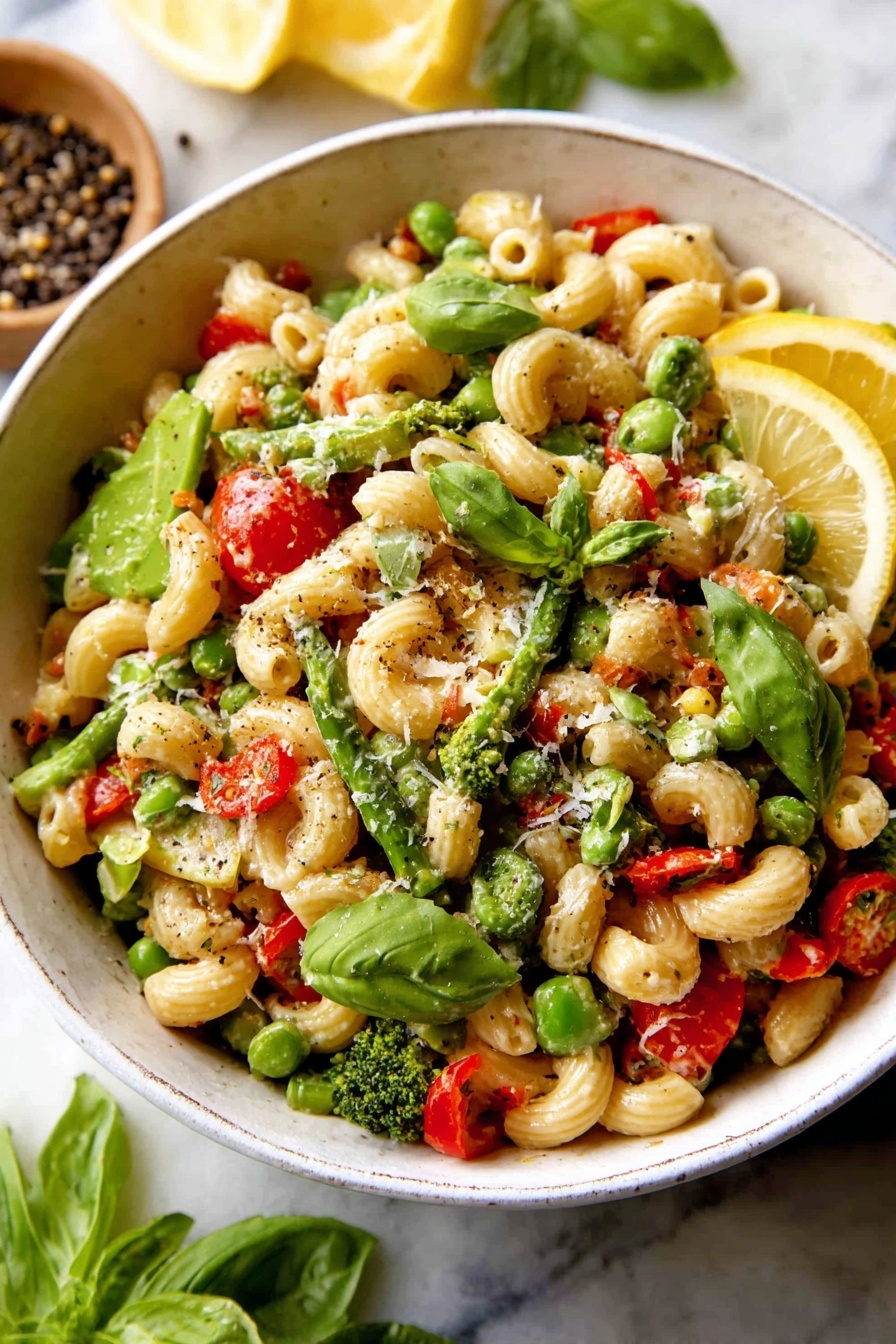
Garnishes
I love finishing this pasta primavera with extra freshly grated Parmesan and a few torn basil leaves for aroma and presentation. Sometimes I add a drizzle of good olive oil or a sprinkle of toasted pine nuts for a little crunch.
Side Dishes
A crisp green salad with a simple vinaigrette or garlic bread on the side rounds out the meal perfectly. If you want a heartier option, a roasted chicken or grilled fish pairs beautifully without overpowering the pasta’s fresh flavors.
Creative Ways to Present
For a special occasion, try serving the pasta primavera in individual shallow bowls with microgreens on top and a twist of lemon zest. It makes the dish feel elevated while keeping it approachable and fresh.
Make Ahead and Storage
Storing Leftovers
When I have leftovers, I store the pasta primavera in an airtight container in the fridge. It keeps beautifully for up to five days, making it a perfect meal prep dish.
Freezing
I don’t usually freeze this dish because the cream sauce can separate, but if you want to, freeze it without the cream sauce (just pasta and veggies), then reheat and add fresh sauce later for best results.
Reheating
Reheat gently on the stove over medium-low heat, stirring frequently. Add a splash of milk or broth to loosen the sauce and keep things creamy. It also reheats well in the microwave with a bit of added liquid to prevent drying out.
Frequently Asked Questions:
Absolutely! To keep it vegetarian, just swap the chicken broth for vegetable broth. For vegan, use a plant-based cream alternative like coconut cream and substitute Parmesan with nutritional yeast or a vegan cheese option.
Short pasta shapes like cavatappi, penne, fusilli, or orecchiette are ideal because their curves and twists catch the sauce well, making every bite flavorful.
The key is quick sautéing over medium-high heat just until veggies are tender-crisp. Avoid overcrowding your pan and use a timer so you don’t overcook. Removing them from the pan as soon as they’re done prevents carryover cooking and sogginess.
Yes! You can cook pasta al dente and veggies separately, store them in airtight containers, and combine with sauce when you’re ready to serve. This keeps everything fresh and lets you reheat gently without overcooking.
Final Thoughts
This Healthy Vegetable Pasta Primavera Recipe has become a staple because it’s flexible, flavorful, and feels homemade without fuss. I genuinely believe you’ll enjoy making it as much as eating it — it’s the kind of dish that feels like a celebration of fresh produce and good company. Give it a try next time you want a healthy, satisfying meal that doesn’t skimp on taste or comfort.
Print
Healthy Vegetable Pasta Primavera Recipe
- Prep Time: 15 minutes
- Cook Time: 15 minutes
- Total Time: 30 minutes
- Yield: 6 servings
- Category: Main Course
- Method: Stovetop
- Cuisine: Italian
- Diet: Vegetarian
Description
This vibrant Pasta Primavera recipe features a colorful medley of fresh vegetables sautéed to tender-crisp perfection and tossed with cavatappi pasta in a creamy, herb-infused Parmesan sauce. A perfect balance of flavors and textures, ideal for a hearty yet light meal that celebrates the best of spring produce.
Ingredients
Pasta
- 12 oz cavatappi or other short pasta such as penne, fusilli, or orecchiette
Vegetables
- ½ medium red onion, chopped
- 2 cups broccoli florets, cut into 1-inch pieces
- 1 medium yellow squash, sliced and quartered
- 1 medium zucchini, sliced and quartered
- 8 oz asparagus, trimmed and cut into 1 ½-inch pieces
- 1 medium red bell pepper, chopped
- 1 ½ cup cherry tomatoes, halved
- 1 ½ cups frozen petite peas, thawed
- 4 cloves garlic, minced
- ¼ cup fresh basil, chopped
Oils and Seasonings
- 4 tablespoons extra virgin olive oil, divided
- Salt, to taste (about ½ teaspoon used in total)
- Black pepper, to taste (about ½ teaspoon used in total)
- ¼ teaspoon red pepper flakes
- 1 ½ teaspoon dried oregano
- 1 ½ teaspoon dried parsley
- ½ teaspoon dried thyme
Liquids and Thickener
- 1 cup heavy cream (or substitute evaporated milk)
- 1 ½ cups chicken broth
- 1 tablespoon cornstarch
- 2 tablespoons lemon juice
Cheese
- ¾ cup freshly grated Parmesan cheese, divided
Instructions
- Cook Pasta: Bring a large pot of salted water to a boil. Add the pasta and cook according to package directions until al dente, about 10-12 minutes. Reserve ½ cup of pasta water before draining the pasta. Set pasta aside.
- Sauté Vegetables: In a large deep saucepan or skillet, heat 3 tablespoons of olive oil over medium-high heat. Add chopped red onion and broccoli florets. Sauté for 3 minutes until vegetables start to soften but remain crisp.
- Add More Veggies: Add yellow squash, zucchini, asparagus, red bell pepper, and cherry tomatoes to the pan. Season with ¼ teaspoon salt and ¼ teaspoon pepper. Sauté for 2 more minutes until vegetables are tender-crisp. Remove the vegetables from the pan and transfer them to a large bowl; set aside.
- Prepare Sauce Base: In the now empty skillet, heat the remaining 1 tablespoon olive oil over medium heat. Add minced garlic and red pepper flakes, sautéing for about 30 seconds until fragrant. Reduce heat to low and pour in the heavy cream.
- Thicken Sauce: In a small bowl, whisk together chicken broth and cornstarch until smooth. Add this mixture to the skillet along with dried oregano, parsley, thyme, and ¼ teaspoon salt. Bring the sauce to a gentle simmer and cook for 3-5 minutes until thickened.
- Add Cheese and Flavor: Stir in ½ cup freshly grated Parmesan cheese until melted and smooth. Then add the lemon juice, thawed peas, and chopped fresh basil, warming everything through on low heat.
- Combine Pasta and Vegetables: Return the sautéed vegetables to the skillet with the sauce, stirring to coat evenly. Add the cooked pasta and toss to combine. Add reserved pasta water a little at a time if the sauce needs thinning to preferred consistency. Season with additional salt and freshly cracked black pepper to taste.
- Serve: Garnish the pasta primavera with the remaining ¼ cup freshly grated Parmesan cheese or more as desired. Serve immediately.
Notes
- Do not overcook the vegetables to maintain a tender-crisp texture essential for a successful pasta primavera.
- Cook pasta al dente to avoid mushy texture, testing a few minutes before the package time.
- Use a large, deep saucepan or braiser to accommodate the pasta and vegetables comfortably for even cooking.
- Feel free to vary vegetables based on availability and preference, balancing texture, color, and flavor.
- Use freshly grated Parmesan cheese for the best flavor and texture in the sauce and garnish.
- If adding protein, adjust vegetable quantities or increase sauce to maintain flavor balance.
- Store leftovers in an airtight container in the refrigerator for up to five days and reheat gently with a splash of milk or water to loosen the sauce.
- Prepare pasta, vegetables, and aromatics ahead and store separately for easy assembly later.
- Add lemon juice to taste for desired citrus brightness.
- To reheat, microwave in intervals with milk or water added, or reheat on stovetop over medium-low heat with stirring.
Nutrition
- Serving Size: 1 cup
- Calories: 420 kcal
- Sugar: 6 g
- Sodium: 520 mg
- Fat: 18 g
- Saturated Fat: 7 g
- Unsaturated Fat: 10 g
- Trans Fat: 0 g
- Carbohydrates: 50 g
- Fiber: 5 g
- Protein: 14 g
- Cholesterol: 35 mg

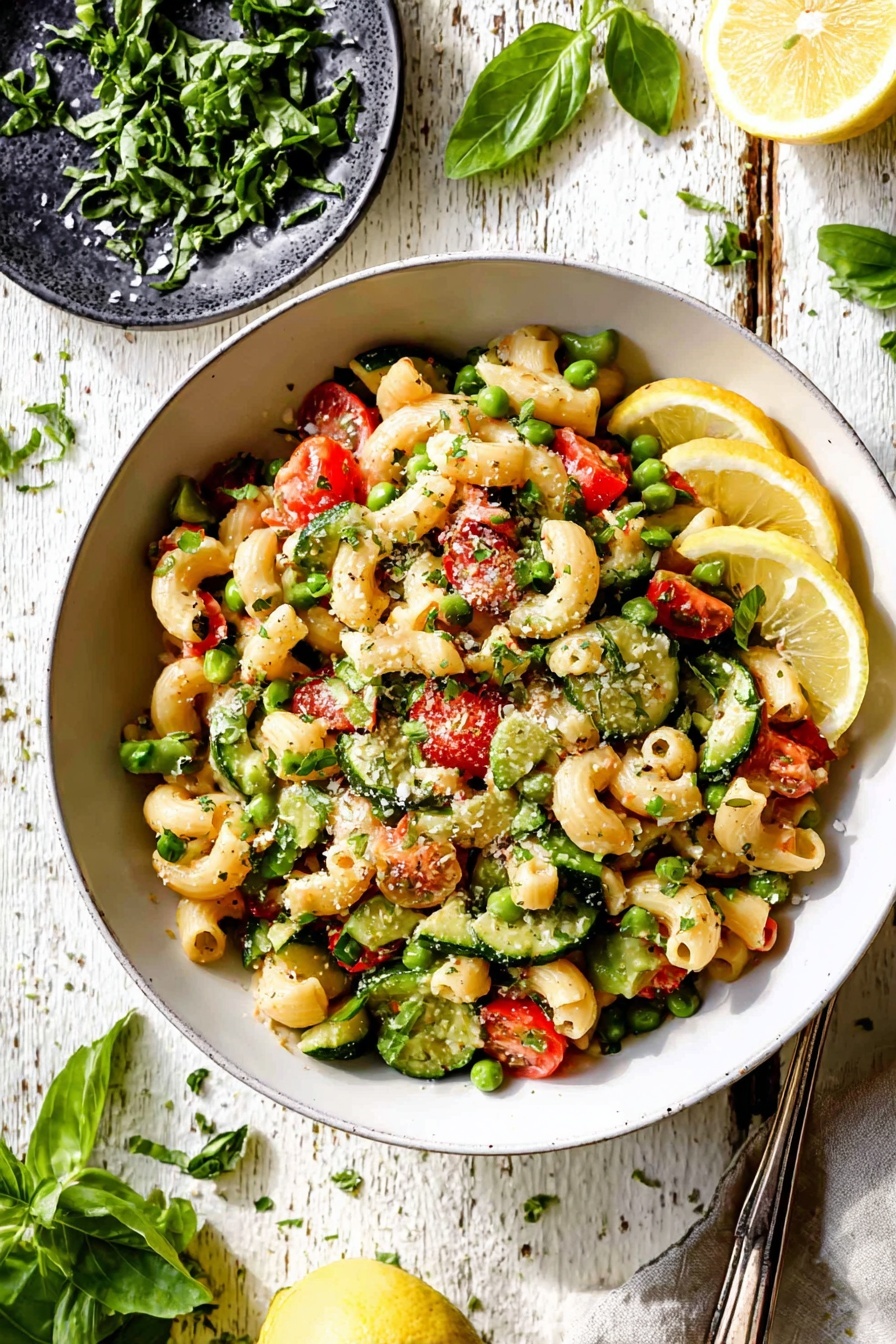
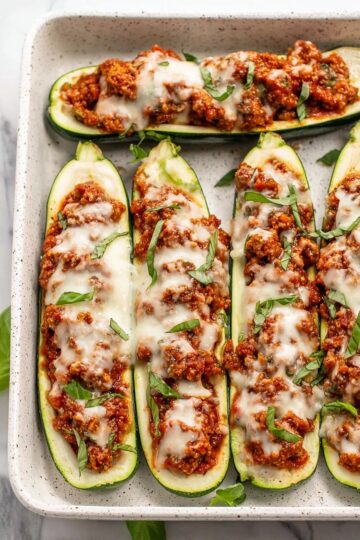



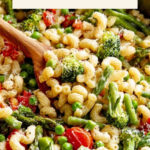
Leave a Reply